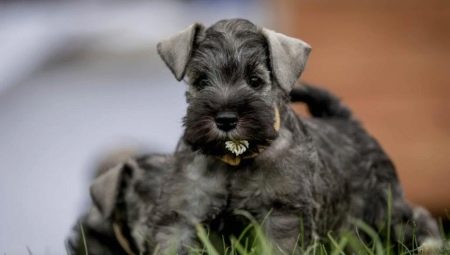Among modern varieties of dogs there are a lot of charming, smart and loyal representatives. One of the striking examples is the Giant Schnauzer breed. They differ from other dogs in a massive body, as well as a charming beard and mustache, which give these pets the appearance of a wise old man. In this material you will get acquainted with the most interesting information about Giant Schnauzers: the history of the breed, especially the feeding and keeping of these dogs.
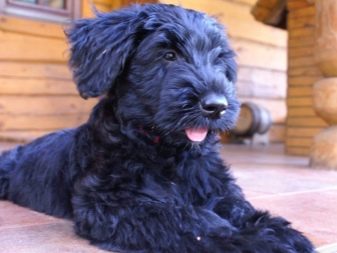
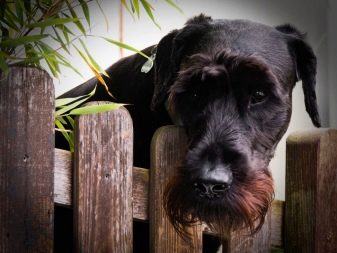
History
Today, it is believed that Germany is the birthplace of the Giant Schnauzers, but this is only widespread, but not reliable information. There are several versions of the origin of this breed of dogs.
- The main official version reports that the Giant Schnauzers were bred at the end of the 19th century to help German shepherds. It is believed that these dogs helped drive cattle and guarded the herd and pets from wild animals and thieves.
- This version is inclined to believe that the breed was bred exclusively for hunting activities. This is indicated by both the exterior of the animal, the type of coat, and some entries in the stud books of breeders of the early 20th century.
- According to another version, the ancestors of the Giant Schnauzers first appeared on the territory of modern Bavaria. The ancestor of the rizen in this version is a wire-haired pinscher. The fact that this breed of dogs participated in the formation of Giant Schnauzers, not a single breeder doubts.
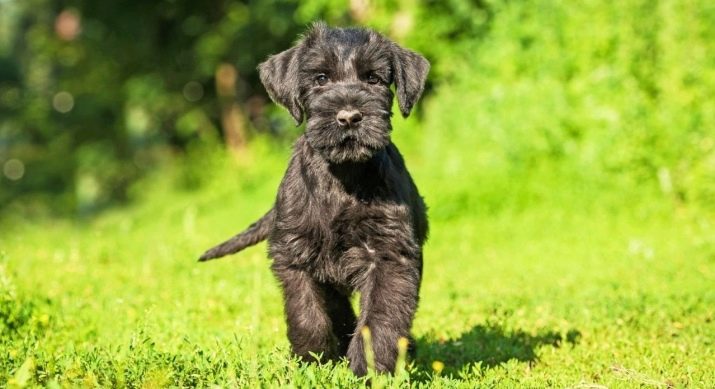
Many countries tried to appropriate the honor of the birth of this unique breed. The difficulty in determining the homeland of these dogs arises from the complete absence of records of the species until the beginning of the 20th century.Regardless of which version is still true, all breeders are inclined to believe that these dogs have a rich historical heritage and came from indigenous breeds of dogs.
Below, it will be considered a common official version of the origin of this breed. Based on it, it is believed that the first representatives of these dogs were first shown only in 1909 at an exhibition in Munich. All 9 individuals represented were originally from Munich and had an almost identical exterior, which made it possible to distinguish this breed from other German mestizos.
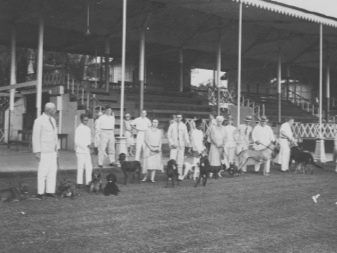
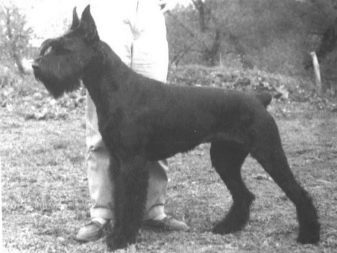
Despite the fact that 9 individuals presented at the exhibition in 1909 were far from purebred representatives of modern Giant Schnauzers, further breeding activities were carried out on the basis of their genetic material. The active work of German breeders lasted at least 20 years, during this time, breeders culled hundreds of individuals with insufficiently proportional limbs or body, weak immunity. An interesting fact: to determine the ideal of this breed, individuals of the Mittelschnauzer breed were used, which by the beginning of the 20th century already had a formed exterior and were popular in Germany and throughout Europe.

This breed received official recognition only in 1925 in Germany. Around the same time, the first standard was formed, on the basic principles of which they rely today. The breed was designated as service, which gave impetus to the further breeding and use of these dogs in everyday life. As soon as the rizens got official status, in the same year the pedigree registers of this breed were replenished with more than 30 individuals with the characteristics of a purebred rizenschnauzer.
Unfortunately, the names of only three individuals of the 9 that took part in the breeding of Giant Schnauzers are known. However, it can be considered that most of the modern purebred representatives have exactly these three dogs in their pedigree: Batsi, Roland and Fels.
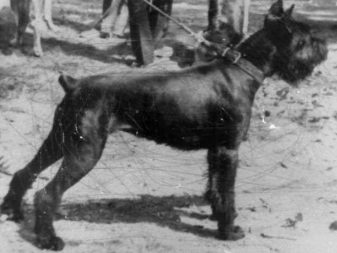
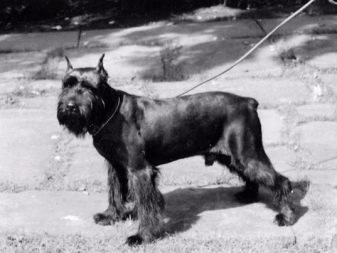
The Second World War had a detrimental effect on the development of many breeds, among them were Giant Schnauzers. Since 1956, the first attempts were made to restore this breed, however, the process progressed extremely slowly due to the small number of purebred individuals.
At the same time, the breed standard was adjusted, where changes were made about the height, weight and appearance of the rizenes. We can say that the standard has become more loyal, since the genetic material of many other individuals was required to preserve the breed. Some breeding breeders allowed breeding with mestizos, which led to a partial loss of identity of these dogs.
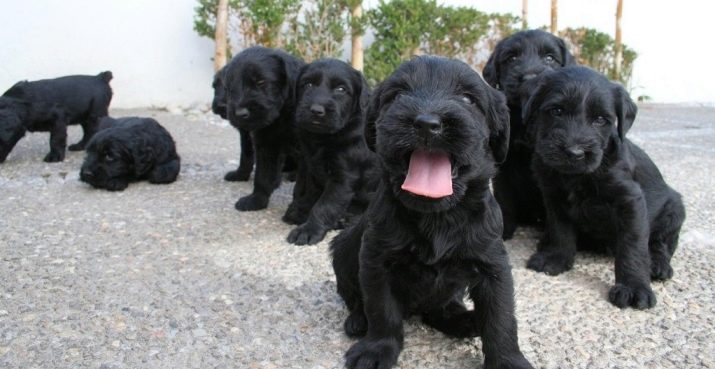
Giant Schnauzers appeared on the territory of the Russian Federation at the beginning of the 20th centuryHowever, none of the Russian breeders made any attempts to breed the breed. A huge role in strengthening this species in the USSR was played by the Red Star nursery. It was here that in about 70 years, 2 Giant Schnauzer puppies were brought (male and female - Akbar f. Raakzee and Annie f. Raakzey). We can assume that the vast majority of modern Russian gingerbread schnauzers are descended from these babies.

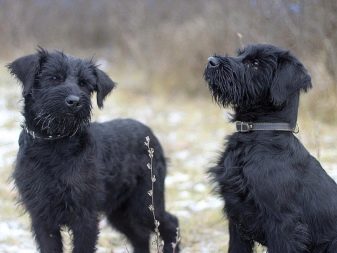
Breed description
The breed of dogs Giant Schnauzer has an individual appearance, which was officially recognized in the first half of the 20th century. The main characteristics of this exterior are presented in the IFF (International Cynological Federation) standard of April 6, 2000.
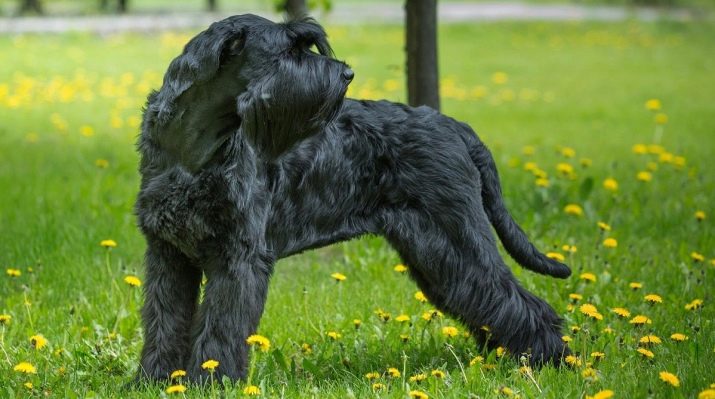
It is worth considering its general provisions.
- Body. Massive, rather compact than elongated, square type. The ratio of the height of the individual with the length of the body is almost the same. Developed muscle groups are clearly felt on the shoulders, shoulder blades and neck. The back is powerful, but rather short, as is the lower back. Croup stands out slightly, roundish type.
- Head. The skull is small, but strong and slightly oblong. The occipital transition is weakly visible. The head looks proportional to the entire body. The forehead is flat type, there are no folds or wrinkles, it is parallel to the back of the nose. The stop is sharp and short, perfectly visible due to the special hair growth.
- Muzzle. Long and massive, wedge-shaped type. Due to the characteristic beard in individuals of this breed, it seems to expand to the nose, but in fact it tapers off.
- Lips. Dark in color, tightly attached to the gums, do not form folds.
- Oral cavity and teeth. Jaws are massive and strong, with well-developed muscles, scissor bite. The teeth themselves (42, based on the dental formula) and fangs are exceptionally white, compactly arranged, close without problems. The entire range of teeth and fangs is hidden in the oral cavity.
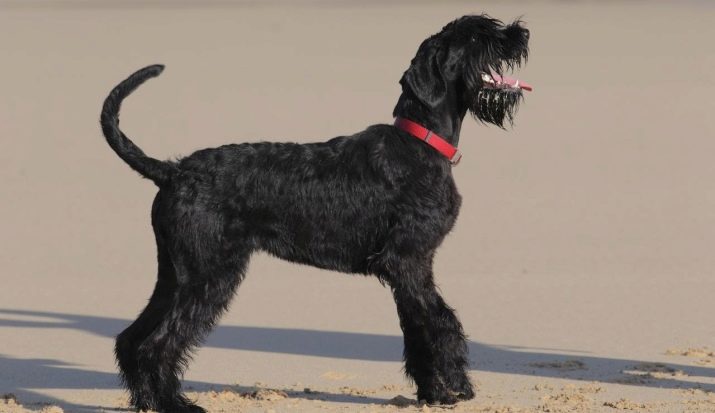
- Eyes. Not too large, almond-shaped or oval. Planted directly, do not stand out against the background of the head. Set at a considerable distance from each other. Eye color is predominantly dark, but there are walnut or honey shades. The eyelids are exceptionally dry, should fit snugly against the eyeball.
- The ears. Set high and far apart. Hang on the cartilages in the shape of a triangle, so that the tips touch the cheekbones of the dog. The ear cavity is closed, but looking forward. The tips of the ears are most often sharp, but due to the abundant amount of hair they seem rounded.
- Neck. Extremely powerful and muscular, although not particularly long, the bend is weakly noticeable. Goes smoothly to the withers. It is thanks to its neck that the Giant Schnauzers look so statically and gracefully. The skin fits tightly on the neck and throat, wrinkles should be absent.

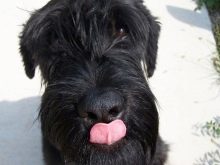
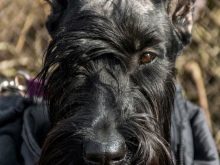
- Rib cage. The chest is wide and massive, remarkably developed, oval in shape, which gives the entire body of the dog an appearance of stateness.
- Stomach. Well tucked up, with a good haircut forms an elegant curved line, starting from the genitals to the oval chest.
- Tail. Not too long, tapering to the tip, sometimes forming a small semblance of a brush. It is covered with a thick layer of wool. In a calm position, sickle-shaped. For exhibition activities, individuals with an uncropped tail are suitable.
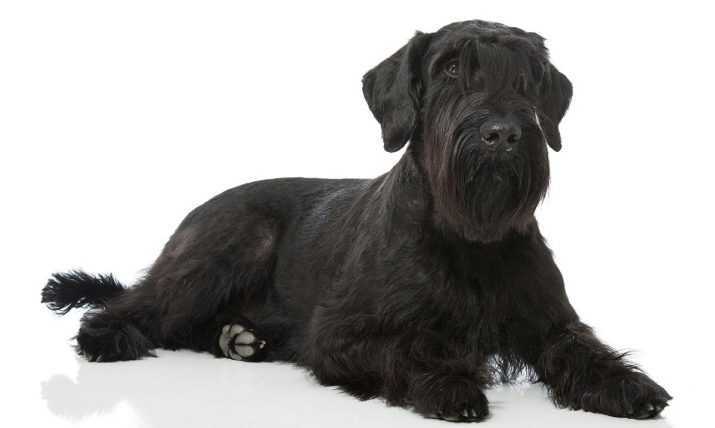
- Forelegs. Straight, sturdy and massive, set parallel to each other. The forearms are straight; a group of well-developed muscles is located on the shoulder blades. The humeral bones also have developed muscles. Elbows set high, adjacent to the chest. The paws themselves are quite short, rounded in shape. The fingers are tightly assembled, the pads are dark and hard. The claws are large, most often it is dark or gray.
- Hind legs. Ate to inspect an individual of this breed in profile, then they are located in parallel, but at a slight slope relative to the body. Delivered quite widely. The knees are well developed, but not turned inward. The legs and thighs are long and extremely muscular, which, together with a powerful hock joint, provides high primary and constant speed. Metatarsus is straight and short, located at right angles to ground level. The shape of the paws is also round, the fingers are tightly assembled.
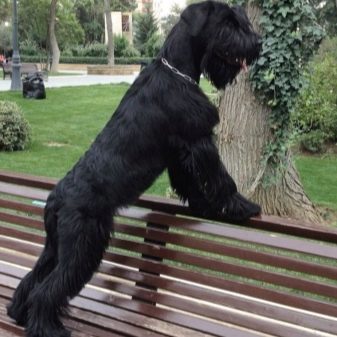
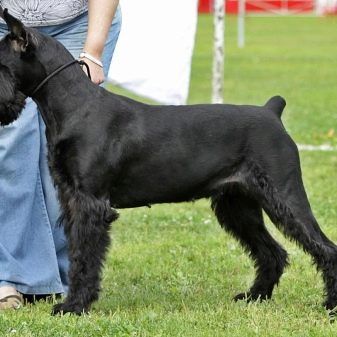
- Leather. Tight to the whole body, rarely forms folds. This is especially true for young individuals. Skin color depends on the color of the dog itself, can be either dark or light.
- Wool. Rigid and wire-like type, slightly stroking when stroking. There is a thick undercoat that provides protection even from the most severe frosts. The length of the coat on the chest, stomach, and back is slightly greater than the length on the head and limbs. An exceptional feature of the breed are pronounced long eyebrows, as well as a long beard that does not touch the hair on the chest. The cheeks near the nose are also covered with a layer of thick wool, which gives the individuals of this dog a special look of a wise old man.
- Color. There are two officially recognized colors of this breed: 1) coal-black (or black-haired), when the whole body is covered with saturated black wool with olive or silver tints; 2) “pepper and salt” - silver, gray or platinum tones with smooth transitions throughout the body are acceptable here. Regardless of the type of color, the face of the Giant Schnauzer should always remain exactly dark (without white spots on the face, head or chest).
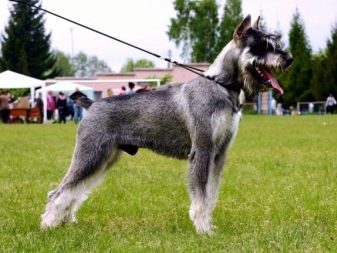
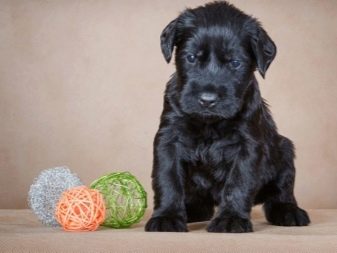
- Movement. These dogs combine ease and breadth with grace and grace in their movements. The hind legs provide pushing power, and the forelegs make the most forward forward possible. The peculiarity of such a movement is precisely the simultaneity: the hind legs provide a push exactly at the time when the front legs swing.
- Medium height. Giant schnauzers are large-sized representatives among their relatives, adult males can grow up to 70 centimeters at the withers, bitches - up to 65 centimeters. Such large sizes will cause a lot of inconvenience when kept in the walls of an ordinary apartment.
- Average weight. As for weight, this breed can seem really gigantic. Giant schnauzer dogs can weigh 45 kilograms, and bitches can weigh 37 kilograms.
- Life span. None of the schnauzer breeds are distinguished by significant longevity. Basically, these dogs do not live longer than 12-13 years, but can live up to 15 years in good conditions.
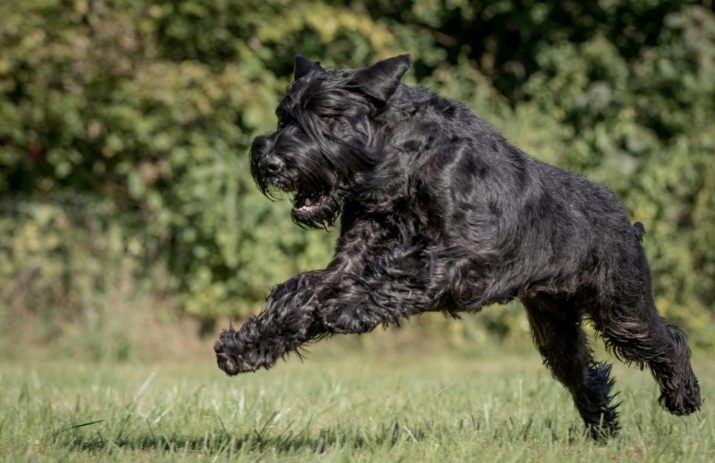
Advantages and disadvantages
Each dog breed has moments that seem more or less pleasant for the owner. It is worth familiarizing yourself with them in more detail.
Positive traits:
- a sharp mind and a strong attachment to a person, which allows you to quickly establish trusting relationships with your family;
- remarkable protective qualities: these dogs until the last breath will protect their master, rush into fire and water to save a member of their family;
- rapid socialization and adaptability to any environmental conditions due to the thick and warm coat, the possibility of keeping on the street and in the aviary;
- the beauty and grace of this breed makes it popular among wealthy people and aesthetes;
- not very high cost relative to other dog breeds.

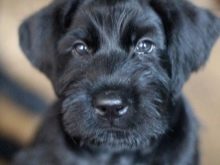
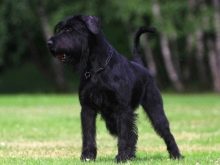
Negative qualities:
- thick hair and frequent molting: these pets need constant hair care, in addition, to maintain a neat appearance of the Giant Schnauzer, it is recommended to regularly take the pet to grooming salons to adjust eyebrows, mustaches and beards;
- an extreme degree of distrust of strangers, which can cause problems when buying an already adult individual who previously had a master;
- in addition, these dogs are most often monogamous;
- predisposition to many pedigree diseases;
- these dogs require a special approach in feeding and keeping;
- if the dog itself is not so expensive, then regular care for it will require significant funds from you.
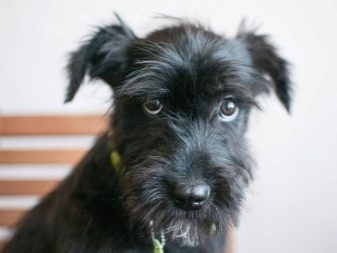
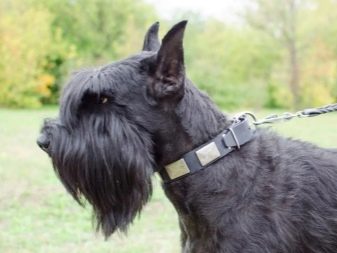
Character Features
When buying representatives of any breed, the owners pay attention not only to the features of their appearance, but also to the character traits inherent in a particular variety of dogs. Below you will find out about the character features of the Giant Schnauzers.
- Communication with the owner. Risen are completely devoted to their owners, they will spend all their free time from walks right next to you. So they feel safe and can protect you from the whole world. These dogs are good primarily as companions and protectors.

- Energy. It is difficult to find dogs more active and cheerful than the Giant Schnauzers. In the open air they frolic like little children, love games and entertainment, can run in the mornings with the owner and do not get tired for a long time. A surge of energy for these dogs is extremely important, otherwise they will express all their enthusiasm in the walls of the apartment.
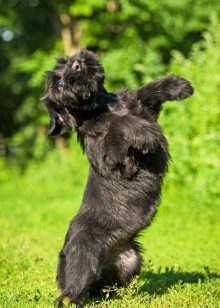
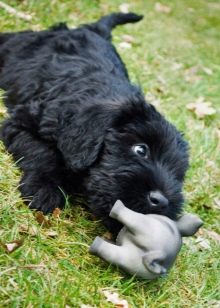
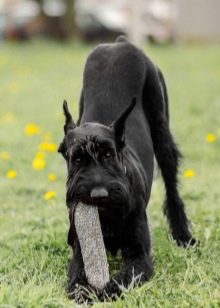
- Attitude towards children. In relation to the small members of their family, rizena are always friendly.They will be happy to take part in any game and venture that kids will come up with, as well as caution the hosts if the fun goes beyond safety. The rizens do not pay any attention to harassment and negligence unless it comes to open aggression and teasing. Some breeders note that these dogs are wonderful nannies that not only protect babies from troubles, but also protect their sleep, protect them from strangers and street animals.
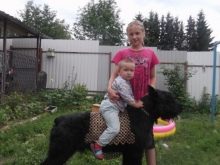

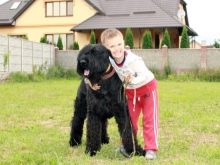
- Self-esteem. There is no doubt that Giant Schnauzers are remarkably aware of their attractiveness and grace. If the owner does not show enough assertiveness in raising the individuals of these dogs, the rizen will constantly try to take a leading position in such relationships. These dogs are very fond of indicating their importance, and also often suffer from a lack of attention. They are struggling with this in a very original way - they are naughty, scatter toys, bark loudly.

- A born hunter. The scent and hearing of the Giant Schnauzers is imprisoned for tracking small game and animals. Having sensed that some small animal or bird is nearby, these dogs can completely lose their sense of time and forget about the owner. In order to control these skills, it is recommended to walk these dogs mainly on a leash so that they are used to calmly reacting to the external environment.
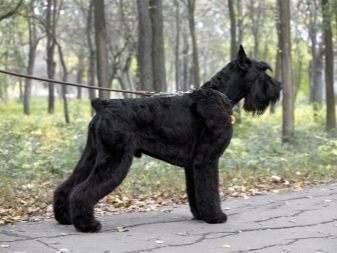
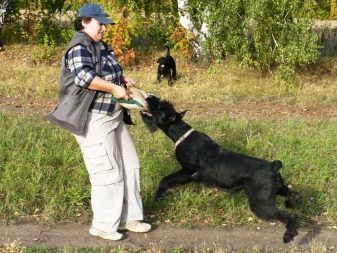
- Relation to other pets. Like all other dog breeds, rizena restrained to other pets. The relations of the Giant Schnauzer with the cat are especially ambiguous - friendly games here are physically impossible because of the size of the dog. If the pets grew together from birth, then such a friendship will certainly be strong and fruitful.
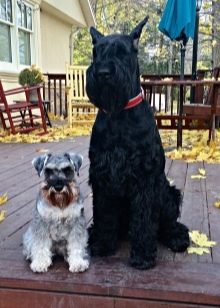
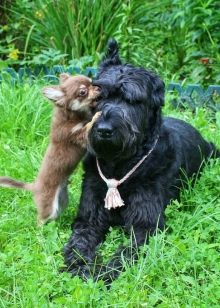
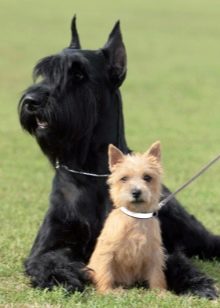
- Attitude to strangers. Despite their good-natured nature, Giant Schnauzers are extremely suspicious of all strangers who enter their personal space or the space of the owner. The pet will not show obvious aggression, however, you should not expect affection from him. At the slightest sign of danger, these "bearded old men" will first bark warningly and then turn into formidable defenders who will not give offense to themselves or their family members.
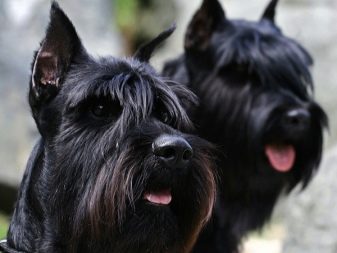
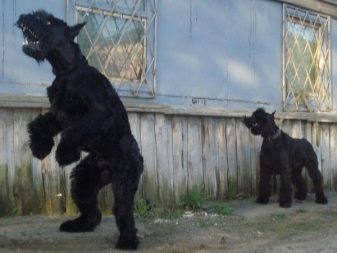
- Bravery. In an extraordinary and dangerous situation, the Giant Schnauzers will not just stand by, but will try to make their "contribution" to the situation. If the situation gets out of control, the risen very quickly assess the state of affairs and clearly act according to their plan.
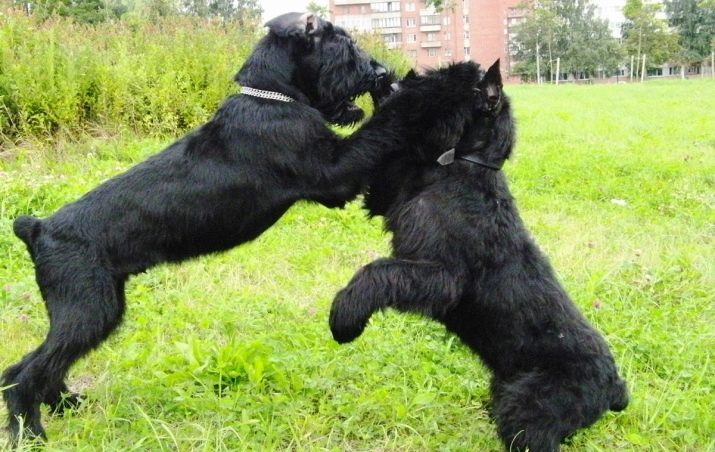
It should be understood that all of these qualities should be gradually inculcated in the course of patient and proper education. In the case of an unfair attitude to the physical and mental health of the dog, the rizena grows aggressive, cowardly, capricious and passive.
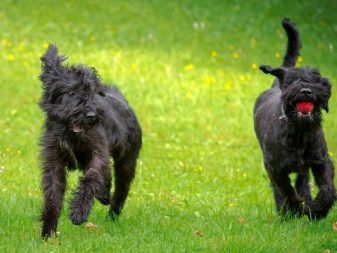
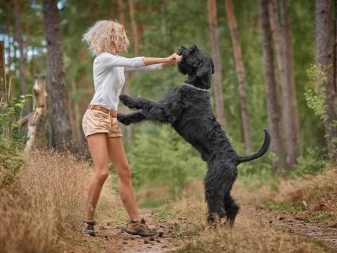
How to choose?
The choice of a Giant Schnauzer puppy should be treated with great attention, the future health of the pet, its mood and energy will depend on your choice.
You have two options when choosing thoroughbred Risen puppies:
- buy in the nursery;
- buy from a private person.
Each of them has its pros and cons, it is worth considering them in more detail.

At a private breeder
pros
- Such individuals, as a rule, are much cheaper than those sold in nurseries. Most often, the price depends on the completeness of the packages of documents, as well as defects in appearance.
- Breeders, unlike nurseries, do not cull individuals with obvious impaired appearance, they only reduce their cost. This allows unprofessional breeders to choose a practically purebred Giant Schnauzer at a budget price.
- As a rule, private breeders pay more attention to individual puppies, as opposed to keeping animals in nurseries, where grooming, vaccination and feeding are, at best, selective and not common to all individuals.
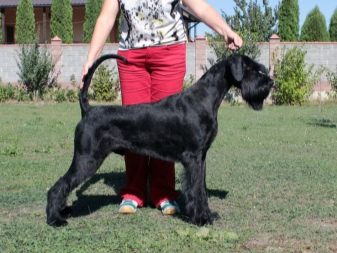

Minuses
- So-called private traders rarely present a full package of dog documents.In the absence of information about the pet’s pedigree, you won’t be able to tell exactly which individuals’ blood is flowing through your dog’s veins. This can result in many diseases in the future.
- Private traders have fewer resources for quality pet care. Most often, these dogs live either in enclosures or in enclosed rooms without access to fresh oxygen and walks.
- Puppies bought from private hands very often have real colonies of fleas and lice on their hair. As a rule, such owners leave pets for maintenance to parents who painstakingly care for puppies only until a certain age.


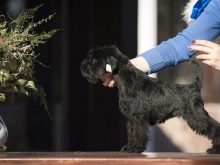
In the nursery
pros
- You get a complete set of documents of the pet and if desired by its parents. You can soberly evaluate the pedigree of an individual, the behavior of its parents and distant relatives. So you will more accurately understand whether a particular pet is suitable for you or not.
- The nursery provides complete control over the health of the animal. This means: conducting regular and timely vaccinations, as well as supplying the diet with vitamin supplements.
- If a private trader can easily imitate quality conditions, then it will be difficult for the nursery to do this. So, you can see live in real life conditions of a pet and its parents.
- Nurseries breed and sell only purebred individuals, which means that you will not receive any surprises and defects in appearance / behavior when the pet grows up. Moreover, in kennels there is a much larger selection of young dogs than when buying from private hands.
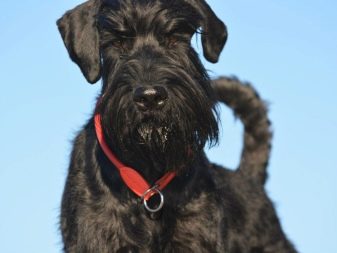
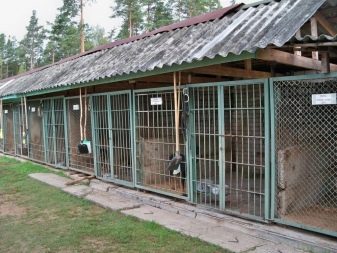
Minuses
- A generalized approach to caring for puppies. In nurseries, the attention of a particular individual is rarely paid (unless, of course, we are talking about pregnancy, injury or estrus).
- High cost due to the availability of all documents and pedigree. However, the nursery workers will certainly give valuable advice on keeping young animals in the walls of the apartment.
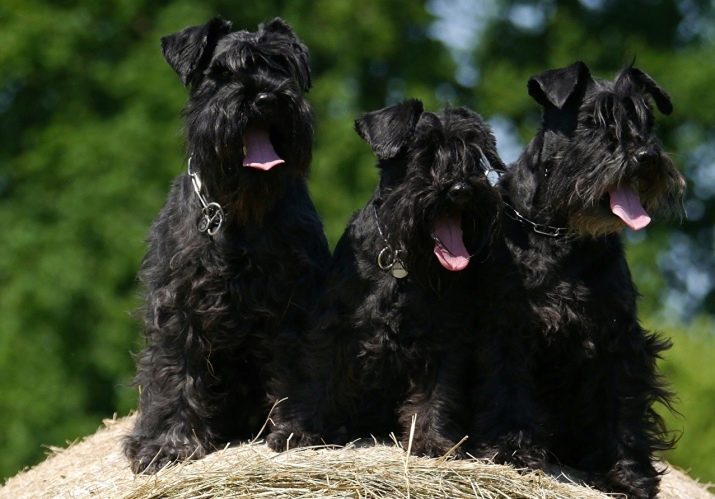
When choosing a puppy in both cases, you should pay attention to other points.
- The appearance of the pet. By the way the pet looks, it is possible to identify defects in appearance, as well as determine the presence of certain diseases. Puppies can feel unwell by the state of their coat and skin. Common signs are lumps, tangles, wet hair and dirty hair in the genital area, redness and itching on the skin, dirty ears, cracks in the paw pads.
- Also follow the fatness of the individual - it is better to take heavy puppies with a strong skeleton. Also pay attention to the color of the eyelids and lips: if it is black, then in front of you is the future representative of the coal-black color.

- Activity. According to the behavior of the puppies, you can also evaluate the current health of the babies and their chances of training. It is better to choose the active kids: they can be trained and accustomed to obedience at any time. But the weak and passive is unlikely to be possible to feed.
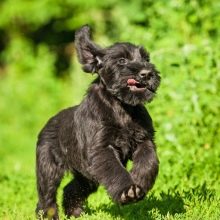
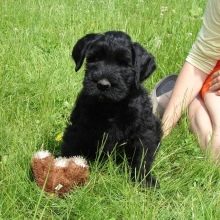
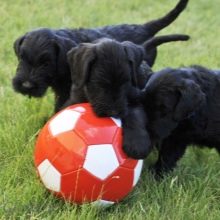
- The age of puppies. Despite the fact that the puppy is not allowed to sell these puppies under 10 weeks of age, it is advisable to start training already in 1.5-2 months. At this age, it is easiest to establish contact with a pet, gain trust and establish your authority. At this stage, it is possible to fix the correct growth of the incisors to form a scissor bite. However, if you are going to represent your pet at exhibitions, then it is worth taking a puppy no younger than 3 months old - up to this age, the puppies' organism is actively formed, and some appearance features may be invisible.
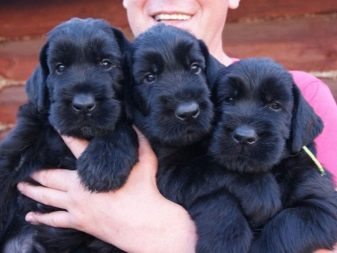
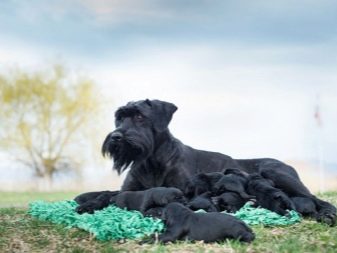
- Package of documents. Regardless of whether you are buying a puppy from private hands or in nurseries, make sure that you have all the necessary documents. These include: metric, pedigree, veterinary passport. Also, you have the right to require documents of the puppy's parents in order to determine the breed predisposition of the individual to diseases and defects.
- Be sure to check the number of babies in your puppy’s mother’s litter. The optimal number is 6-8 individuals.If the breeder speaks of 12-14 individuals, then it is worth giving up such puppies. An excess number of puppies can indicate both prematurity and insufficient vitamin nutrition of certain individuals through breast milk.
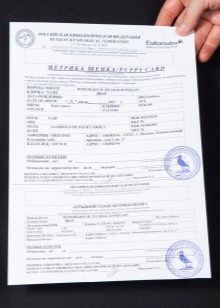
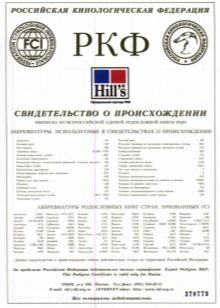
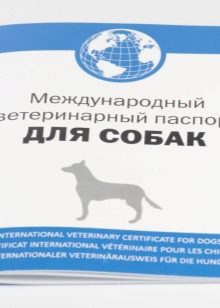
- Destination. Often, breeders immediately display several directions of dogs for each particular breed. This means that the Giant Schnauzer can be bred exclusively for the family, for security activities or for service. It is the family Bavarians who are suitable for buying into an ordinary family with children: they are more friendly, less aggressive and tend to trust every member of the family. Office rizenschnauzers are extremely stubborn, distrustful and aggressive - they can be raised only by professional breeders.
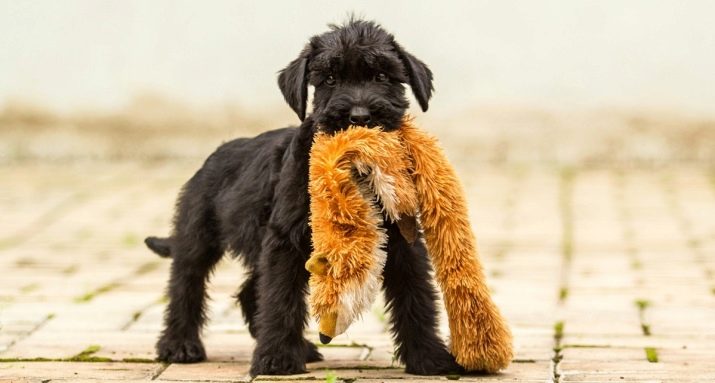
- Conditions of detention. Visit the place of keeping the pet before your purchase, as well as the place of keeping its parents. So you get an idea of the approximate conditions of care and feeding, and you can also decide whether to trust an individual breeder. Also, having familiarized yourself with the conditions of keeping newborn puppies and their diet, it will be easier for you to create identical conditions of detention in your apartment.
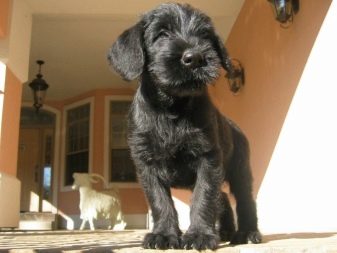
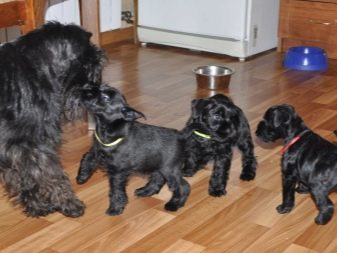
Today kennels with puppies of Giant Schnauzers can be found in every major city in Russia. The price for them is not very large and greatly depends on individual external qualities. As a rule, purebred puppies do not cost more than 30–35 thousand rubles.
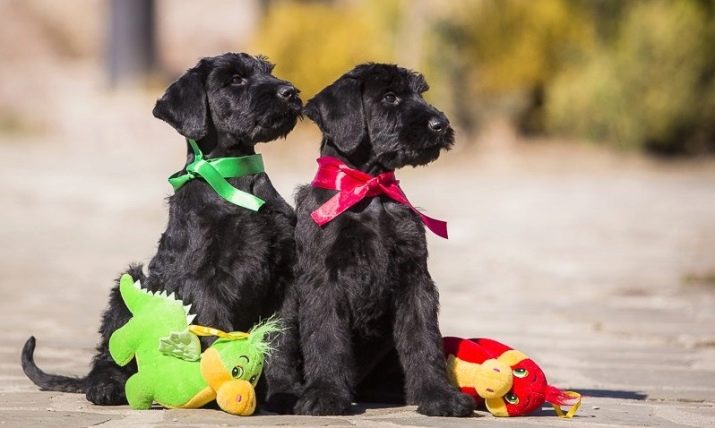
Conditions for keeping
If in nutrition and care the Giant Schnauzer is no different from other dogs, then as regards the conditions of detention, everything is more complicated.
- Place of detention and activity. Riseny belong to such dogs, which can be kept both in the apartment and in outdoor conditions. Their coat and undercoat are quite dense and warm to protect pets from severe frosts and drafts. The best option for keeping the animal will be a closed aviary or a section of a private house with a reliable booth or covered house with constant access to fresh air.

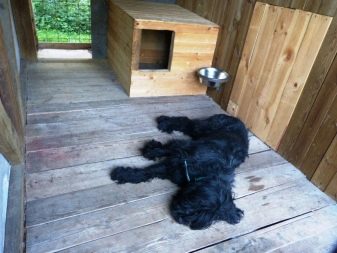
- Walking. Try to walk your dog at least twice a day. Adult dogs need a one-hour walk, young dogs need a half-hour walk. Some are of the opinion that these dogs should be walked only after reaching 3-4 months, which is a very gross mistake. Late acquaintance with the street, domestic animals and strangers can irreparably affect the socialization of the animal - it will make it shy, angry or aggressive. For walks, you should choose a strictly defined time every day, while you need to walk before eating.
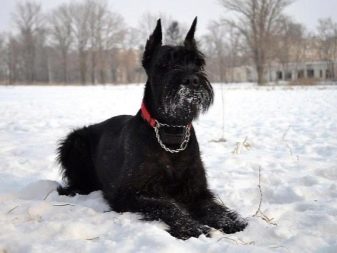
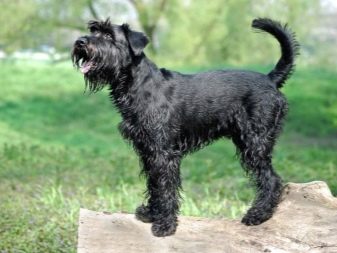
- Energy. Regardless of the place of keeping the dog, you should constantly provide it with physical activity and training. There will not be enough 2 ordinary walks a day, where you just drive your pet around the yard, and he will cope with his needs. Risens must run, jump, chase birds, look for insects in the grass. Passive lifestyle not only leads to obesity, but also negatively affects the psyche of the animal.
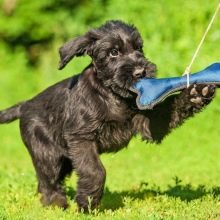
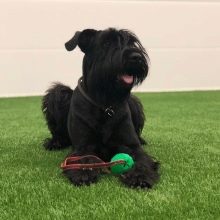

- Freedom. In no case should you put a Giant Schnauzer on a chain. These dogs are extremely freedom-loving and feel depressed on a chain that is akin to a real prison for them.


- Contact. Riesens are extremely sociable and inventive with their family, and therefore their place in the apartment should be visible and have eye contact with other rooms. These dogs are very fond of just watching their owners and even imitate some of their movements and reactions. Riesens are able to remain alone for a long time and independently provide for themselves, but too long separation will make them pessimistic, lethargic and passive. Do not be afraid to take these pets on hikes and barbecue - they love to spend time actively and have fun outdoors.
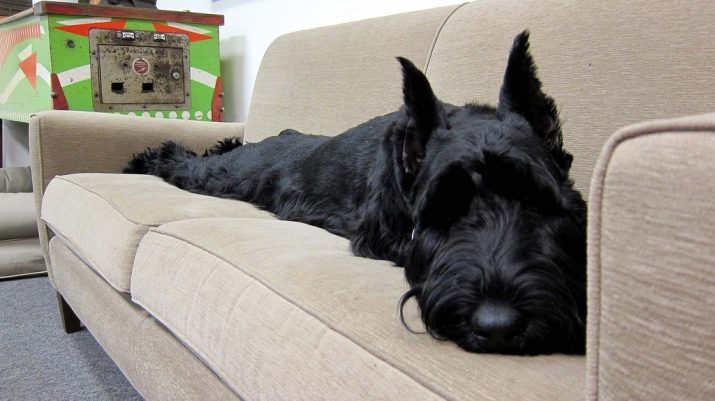
Food
It’s hard to call the food of the Giant Schnauzer any exceptional or special.All the rules that are used by experienced owners in feeding all other dog breeds apply here.
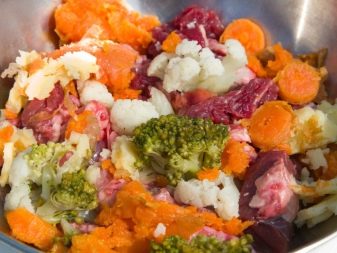
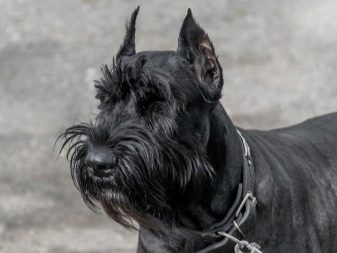
The list of the most healthy natural products includes the following:
- all types of lean meat (lamb, hare, turkey, veal), meat is served in boiled or raw form with vegetables or cereals, and chicken and pork should be discarded;
- offal - cartilages and bones come in well (the main thing is that they are non-tubular type);
- dairy products (kefir, cottage cheese, cheese);
- vegetables (tomatoes, celery, cucumbers, beets);
- fish products (boiled sea fish);
- cereals from cereals (rice, buckwheat, millet, oatmeal).

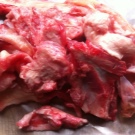
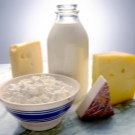

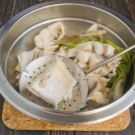
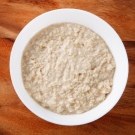
For young puppies, it is especially useful to add the so-called brain bones to the diet. They will help with the stabilization of the digestive tract and will serve the pet perfectly during the period of growth and change of teeth.
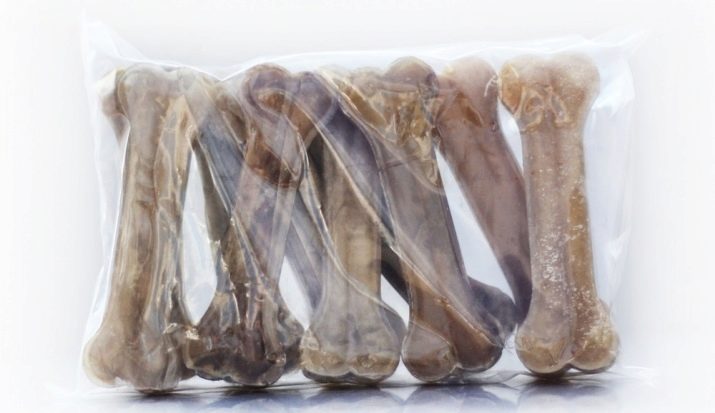
In addition to the main dishes, some additives may be added to the Giant Schnauzer diet, including: greens (parsley, dill, celery leaves), animal and vegetable oils, seaweed (a rich source of iodine and vitamins A, C, E, D, B1, B2, B6,). You can mix dried or fresh fruits (apples and pears) in your pet's serving as additives. They will provide the body with the necessary fiber, but do not forget that about 1/3 of the diet of a young puppy should be meat products.



If you have chosen the option of feeding ready-made feeds, then you should dwell on the varieties such as “premium” or “super-premium”.
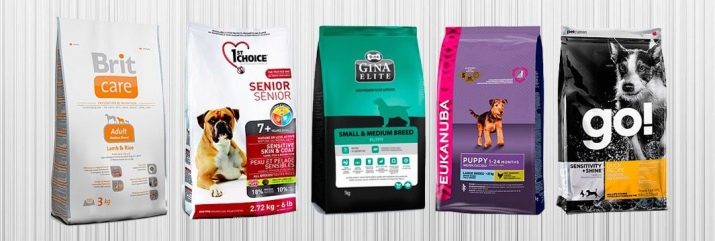
If we talk specifically about unacceptable food, then its list for Risen is not so great. These are omnivorous dogs, and the diet here should be limited only to clearly harmful products, the list of which will be located below. Here are some tips for feeding these dogs.
- First of all, remove all fatty, pickled, salty, spicy and smoked foods from the diet. Human food is not suitable for the intestines of any dog. The same goes for feeding right from the table and begging. Despite the fact that such food can seem incredibly tasty to the pet, it will cause irreparable harm to its health.
- Eliminate foods high in sugar: sweets, candies, chocolate, pastries.
- Excess protein in foods is also harmful to rizena. It is not recommended to combine meat, fish and egg white in one serving.
- If for other dogs it is preferable to boiled meat, then for rizenschnauzers raw meat and bones are even more useful.
- When serving meat or other food to a healthy adult Giant Schnauzer, do not grind it and bring it to a mushy state. This will damage the development of teeth, the formation of a bite, and also affect the digestion of food.
- Regardless of the season, it is worth adding vitamin supplements and complexes to the diet. Even despite their excellent health and thick coat, Giant Schnauzers are prone to colds and viral diseases.
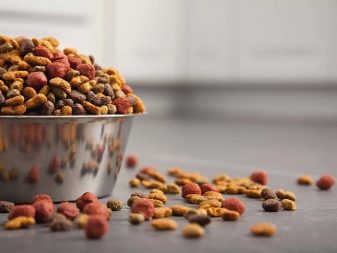
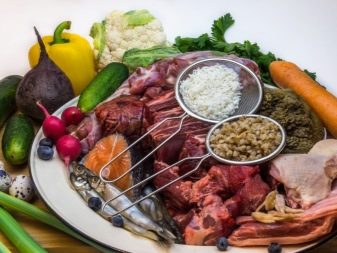
Care Rules
The health and vitality of the Giant Schnauzer depends not only on proper nutrition or conditions of detention, but also on the regularity of care for his appearance. The basic rules here relate to the provision of banal hygiene and preventive procedures at least 1 time per week.
Wool
The rizenes have a wonderful and beautiful long coat, which, unfortunately, grows very quickly and prevents the dog owners from living. If in the case of other dogs regular brushing or washing can help, then a much more radical approach is required. As a rule, owners prefer to regularly visit grooming salons (adjusting the appearance of the animal’s hair) or independently trim a pet at least once a year.
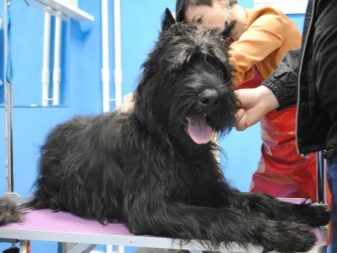
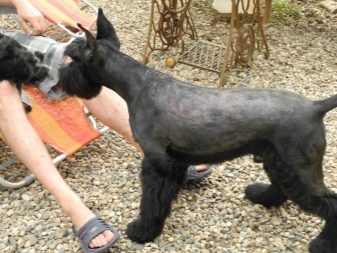
For the procedure, you will need a trimming knife or comb with frequent metal cloves. In appearance, this process looks like a real peeling of all the hair of a pet, but everything is completely different.During this procedure, only the hard outer hair is removed, and not the undercoat itself, which warms the animal and protects it from moisture and frost. Unlike a regular haircut, this procedure is much longer (up to 6 hours) and may be completely displeasing to your pet in the early stages. It should be accustomed to it gradually, while do not trim too often so as not to weaken the undercoat itself.
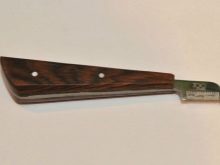
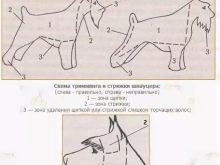
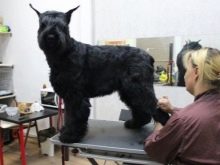
As a replacement for the trimmer, rollers or furminators can be used.
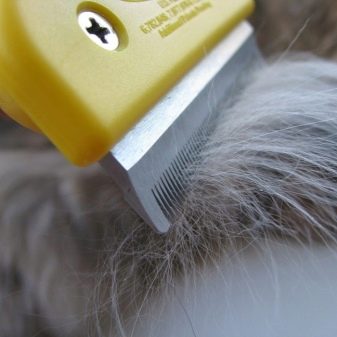

Experienced breeders recommend trimming or grooming to process the animal’s hair on the body - the hairs on the head and face are advised to undergo a specific haircut. It is carried out according to the following scheme:
- all the hair is trimmed to the head, a semblance of a long bang is formed on the head;
- the length of the eyebrows is completely preserved (monobrow is divided);
- all hair from the neck and chest is removed, while remaining on the face;
- the upper part of the hair on the face to the nose is sheared (or partially corrected) so that there remains a small disheveled mop of hair at the very lobe;
- on the cheeks and chin, the length of the hair is preserved and combed down, a beard and mustache are given a uniform and smooth falling appearance;
- hairs shaving in different directions are cut or stacked.

The washing up
Clean the Giant Schnauzer no more than once every few months. If after walking the animal’s hair is dirty, limit yourself to a small shower or rags to wipe the paws and hair near the genitals. The coat of this breed of dogs is oily, dirt or moisture does not linger on it, and therefore it is worth washing the shampoo of such dogs only if necessary.
After each meal, carefully wipe the beard and mustache of the pet - from food and fat, they can turn yellow, break, or just sour.
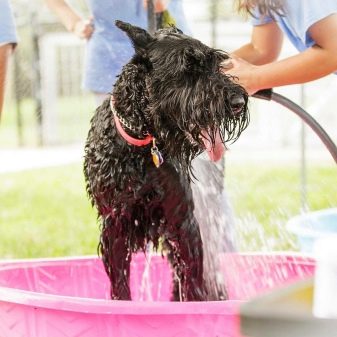

Hygiene
Do not forget about regular procedures for caring for the teeth, claws and ears of the animal. To do this, you need a toothpaste and brush for large breeds of dogs, as well as a nail clipper.
In addition, in the case of rizena, there is a tendency to stop ear. This procedure is done to give them an elegant, standing shape. True, these dogs need to glue cropped ears with a plaster - to fix them in a given position and prevent infection of wounds. This procedure should be entrusted to professionals, at home there is too much chance to harm the health of the animal, there is even a risk of permanently leaving the pet deaf.

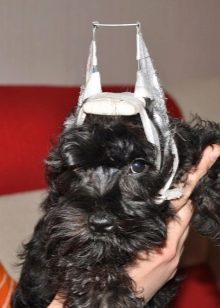

Owner reviews
Judging by the reviews on the open spaces of the network, Giant Schnauzers are loved by the vast majority of their owners. Everyone notes the incredible devotion, kindness and intelligence of these animals, as well as their ability to catch everything on the fly during training.
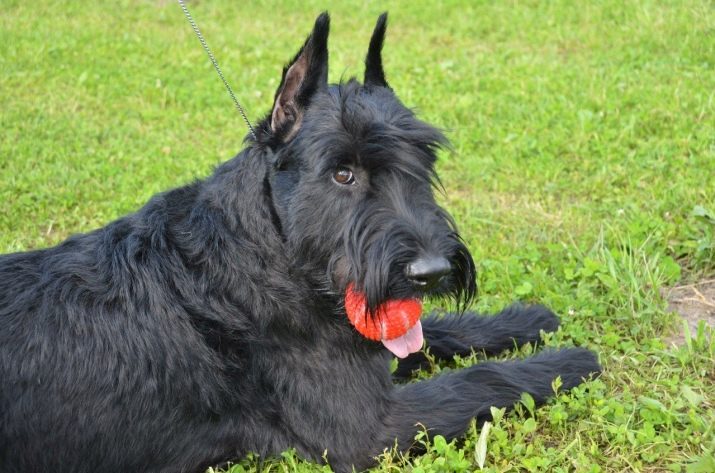
Among the problem points stand out:
- the complexity of caring for the appearance of the pet, because the wool requires maximum attention;
- hyperactivity of the breed - these dogs, according to many breeders, are unsuitable for keeping in small apartments and need constant training, walking and physical activity.
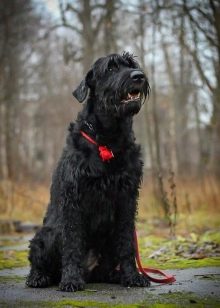
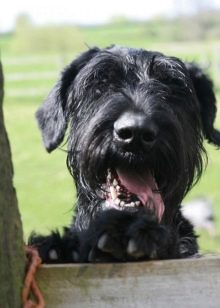
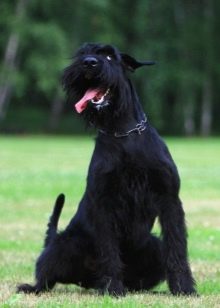
Even more interesting and informative information about the Giant Schnauzer breed in the next video.
